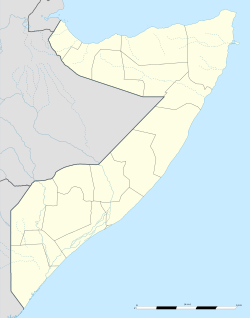Buur Heybe
| Buur Heybe | |
|---|---|
| Village | |
| Location in Somalia. | |
| Coordinates: 3°00′00″N 44°19′00″E / 3.00000°N 44.31667°ECoordinates: 3°00′00″N 44°19′00″E / 3.00000°N 44.31667°E | |
| Country |
|
| Region | Bay |
| Time zone | EAT (UTC+3) |
Buur Heybe ("the mountain of the clay sand") is a small village in the southern Bay province of Somalia. It is the largest of several granitic inselbergs in the region's Doi belt.
The Gogollis Qabe or Gogoshiis Qabe ("the furnished place"), a local rock shelter, is the seat of the first professional excavation in the country. In 1935, Grazioni found a Middle and Later Stone Age archaeological sequence here. The ancient implements belonged to the Somaliland Stillbay culture typified by points and scrapers produced through flat percussion flaking. J.D. Clark a decade later excavated a nearby site, the Gury Waabay ("the poisonous house"), located around half a kilometer to the north. In the 1980s, Brandt also excavated the granitic inselberg, uncovering a top level Holocene layer. Fourteen burials were found therein, which constitute the earliest chronometrically dated burials from the Horn of Africa and contain the earliest definitive grave artefacts in the wider region. A lower layer was likewise associated with the Stone Age Eibian (Doian) industry. Another local rock shelter is referred to as Abka Eeden I Oboy Haawo ("Adam and Eve's court"). In addition, several rock formations in the area feature cave art.
Buur Heybe historically served as a key religious and political hub. According to oral tradition in the Doi ("red soil") belt, several dynasties were based in the town. The Eyle aver that the area was at various times invaded and occupied by a succession of early Cushitic settlers, the Jidle, Maadanle and Ajuran, whom they each managed to defeat. A number of ancient burial sites dated from this pre-Islamic period sit atop the mountain's peak, and are a center of annual pilgrimage (siyaro). A trench near the holy places is said to serve as a passage toward heaven (siraad), and as such is off-limits to individuals possessing a nefarious past. These burial sites on the mountain's summit were later made into Muslim holy sites in the ensuing Islamic period, including the Owol Qaasing (derived from the Arabic "Abdul Qaasim", one of the names of Prophet Muhammad) and Sheikh Abdulqadir al-Jilaani (named for the founder of the Qadiriyya order).
...
Wikipedia

